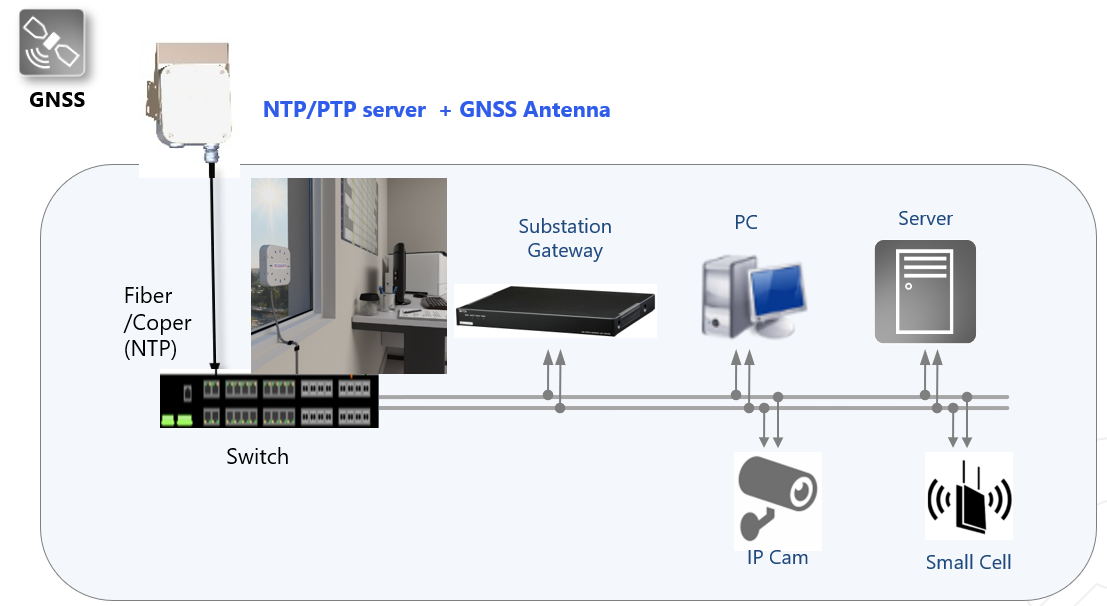A smart GNSS antenna with integrated GNSS receiver and PTP/NTP stacks, can be deployed in deep urban canyons closer to where end applications that require tight synchronization, such as small cells, are located. This avoids the archaic and expensive RF cable feeds of typical GNSS installations. Instead, this uses cost-effective Ethernet cabling and offers both electrical and optical interfaces. Our Integrated GNSS NTP/PTP Server comes in two variants: for outdoor installations on a wall or a pole; and for indoor installations on windows or interior walls. Indoor- or outdoor mounted, even at street level in deep urban canyons, our Integrated GNSS NTP/PTP Server offers unprecedented flexibility. And, with its dual GNSS receivers, PTP grandmaster and NTP server, it delivers the accurate timing that mission-critical applications require.

With the internet of things (IoT) and impending roll out of 5G, small cells are becoming increasingly important. Operators urgently need a way to reliably and affordably deliver new levels of phase accuracy. They require a solution that enables a smooth transition from legacy synchronization. What’s more, they need a device that can be deployed indoor, outdoor and in the most challenging locations. That’s why we offer indoor/outdoor GNSS NTP/PTP Server to effectively deliver small cell synchronization in any environment and eliminate all restrictions. Featuring the industry’s only ultra-compact dual antenna GNSS technology to mitigate interference, it enables total deployment flexibility.

Benefits
- Built-in dual GNSS receivers and antennas enabling NTP and IEEE 1588v2 time servers
- No clear sky view needed.Unique solution that uses the reflected (multipath) signal to achieve excellent synchronization
performance even at street level - Advanced jamming and spoofing detection on device and management levels
- Simple installation and maintenance.Powered over Ethernet. No need for RF cables and no need to correct for cable delays
- Operational simplicity with assurance.The system offers comprehensive monitoring and service assurance
- Compact and green design .Distribution of accurate timing with the smallest size and power footprint on the market
Applications in your network:Highly precise GNSS-sourced synchronization with network-based PTP backup
- Radio access network synchronization including 3G, 4G, 5G (femtocells and small cells as well as macro cells)
- Cable networks (DOCSIS 3.1) and PON synchronization
- Modernized power utilities and media broadcast networks
- Time-as-a service into data center, financial, health and media networks
PTP features
- Full featured IEEE 1588-2008 PTP grandmaster, boundary and slave clocks
- Assisted partial timing support (APTS) – PTP input to backup GNSS outage over network with partial/no timing support
- 1-step clock
- Dedicated or common IP PTP interface
- VLAN (IEEE 802.1Q) or untagged
- Sync-E input to PTP output (frequency) conversion
- Conversion between PTP profiles
- Maintain PTP slaves list
- Fixed and dynamic asymmetry compensation

PTP master modes of operation
- PTP Telecom profiles:
−− ITU-T G.8265.1 & Telecom2008 frequency delivery profiles
−− ITU-T G.8275.2 time/phase delivery profile
−− ITU-T G.8275.1 time/phase delivery profile (full timing support) also used for DOCSIS 3.1 - PTP enterprise profile (mixed IP multicast and unicast)
- PTP power and utility profiles:
−− IEC/IEEE 61850-9-3
−− IEEE C37.238-2011
−− IEEE C37.238-2017 - PTP Broadcast profiles:
−− SMPTE ST 2059-2
−− AES67 Media Profile - IEEE1588v2 default PTP profiles over L3
- Grandmaster simultaneous support for multiple profiles
- Up to 64 unicast slaves @ 128 pps
PTP slave modes of operation
- PTP Telecom profiles:
−− ITU-T G.8265.1 & Telecom2008 frequency delivery profiles
−− ITU-T G.8275.2 time/phase delivery profile
−− ITU-T G.8275.1 time/phase delivery profile (full timing support) - IEEE1588v2 default PTP profiles over L3 (Annex D) and L2 (Annex F)
- PTP enterprise profile (Mixed IP multicast and unicast)
- Designed to support power and broadcast profiles (HW ready)

PTP features
- Up to 64 unicast slaves at 128pps
- Full featured IEEE 1588-2008 PTP grandmaster, boundary and slave clocks
- Assisted partial timing support (APTS) – PTP input to backup GNSS outage over network with partial/no timing support
- 1-step clock
- Dedicated or common IP PTP interface
- VLAN (IEEE 802.1Q) or untagged
- Sync-E input to PTP output (frequency) conversion
- Conversion between PTP profiles
- Maintain PTP slaves list
- Fixed asymmetry compensation
- Ethernet interface
- SFP or combo SFP/SFP+ 1000Base-X (MSA compliant)
Ethernet interfaces
- Hardware-based timestamping
- One combo 1000BaseT (copper) or 1000BaseX (SFP -fiber) port
- Fiber port support SM/MM colored/non-colored SFP and single fiber SFP
Synchronous Ethernet (Sync-E)
- Compliant to the relevant sections of ITU-T G.8261/ G.8262/G.8264
- Supported on ingress and egress
- Ethernet synchronization message channel (ESMC)
- Sync-E input for time holdover during GNSS outage
External antenna
- User-configurable antenna cable delay compensation
- Voltage to antenna +3.3VDC
- Antenna connector SMA-F (50 ohms)
1PPS/CLK out
- User configurable output: 1PPS/10MHz/2.048MHz
- SMA-F connector (50 ohms)
NTP Server
- Smallest NTP server form factor
- Security-hardened NTP server with Hardware-based responder
- Stratum 1 NTP server when locked to GNSS
- NTP v1, v2, v3 ,v4 and SNTP over IPv4 /IPv6
- Hardware-based timestamping
- Within +/–100nsec from UTC
- Support PTP and NTP on same port
- PTP to NTP translation
- Up to 2000 transactions per second
- PTP backup in case of GNSS outage
- Stationary or moving platforms
GNSS receiver
- 72-channel multi-GNSS engine
- Concurrent GNSS (dual frequency)
- Supports single satellite timing modes
−− Survey fixed location
−− Configurable fixed location - Supports navigation mode
- Configurable satellites SNR and elevation masks
- Advanced spoofing and jamming detection on device level
- AI based spoofing and jamming detection based on NMS GNSS assurance
- GPS / QZSS L1 C / A and GLONASS L10F, BeiDou B1
- Supported modes: GPS / GLONASS / BeiDou / GPS+ GLONASS / GPS+ BeiDou, GPS+SBAS (QZSS ,WAAS,EGNOS, MSAS)
- User configurable antenna cable delay compensation
- Voltage to antenna +3.3VDC
- Antenna connector SMA-F (50 ohms)
Internal oscillator
- OCXO Stratum 3E (20-55°C, ΔT=+/-20ºC)
Frequency accuracy
- G.811 compliant PRC while locked to GNSS
Time and phase accuracy
- G.8272 / G.8273.1 compliant PRTC (±100nsec from UTC,MTIE<100nsec) while locked to GNSS
- During GNSS outage: time holdover using a G.811 PRC / G.8272 PRTC Sync-E input
−− Traceable to G.811 PRC: Time Error < UTC +/-1μsec for 24 hrs
−− Traceable to G.8272 PRTC: Time Error < UTC +/- 1μsec for 72 hrs
Indications
- GNSS operation and general fault indication status LED
Monitoring and assurance tools
- Clock Accuracy for up to two clock probes – computing TE and TIE of physical clocks
- Calculation TE/TIE between physical source and reference signals
- Programmable source and reference signals including SyncE, GNSS, PTP recovered clock.
- TE/TIE raw data collection and export to server
- Clock Analysis for up to two PTP clock probes – packet TE/TIE
- Calculation of packet TE/TIE between physical reference signal and timestamps within the PTP packets
- Programmable reference signals including SyncE and GNSS
- TE/TIE raw data colelction and export to server
Management and security
- In-band management (over PTP / Sync-E port)
- Remote CLI – Telnet & SSH (Secure Shell)
- Separate MGMT IP & PTP address
- VLAN and untagged
- System software download via TFTP & SCP (secure copy)
- Enable to disable each of the protocol via CLI
- Alarm log
- Syslog
- Remote authentication via RADIUS
- Remote, secured backup and restore
- Remote, secured SW upgrade
- Low touch provisioning using configuration file
- Multi-level user access
- Access control list (ACL)
- Full management using SNMP v2 / v3 including authentication and encryption
- Alarms, inventory and traps reporting to NMS
- Managed by ADVA Ensemble Controller and Ensemble Sync Director, including GNSS assurance toolkit
Regulatory and standards compliance
- ITU-T G.8261, G.8262, G.8264
- ITU-T G.8272, G.811
- ITU-T G.8265.1, G.8275.1. G.8275.2
- IEEE 1588v2 (PTP)
- ETSI EN 300 386 V1.6.1
- EN 55024
- EN 55022 Class-B
- AS/NZS CISPR 22
- FCC CFR 47 Part 15 Subpart B
- ANSI C63.4 Class-B
- IEC/EN 61000-3-2
- IEC/EN 61000-3-3
- IEC/EN 61000-4-2 (ESD): ±15 kV / ±8 kV (air/contact)
- IEC/EN 61000-4-3 (RI)
- IEC/EN 61000-4-4 (EFT): 1 kV / 50 A (5/50 ns)
- IEC/EN 61000-4-5 (Surge): 4KV (10/700 μs)
- IEC/EN 61000-4-6 (CI)
- EN 60950-1:+A11, +A12, +2 (SAFETY)
- RoHS compliance
Environmental
- Operating temperature: -40 to +80°C / -104 to 176°F
- Storage temperature: -40°C to +85°C / -104 to 185°F
- Humidity: 5 to 95% (non-condensing)
Power consumption
- Max power consumption <1.5W (T >20°C)
Optional accessories
- GNSS (GPS/GLONASS/BeiDou) antenna kits 10/20/60/120/150m (32.8ft/65.6ft/ 196.85ft/393.7ft/492.1ft), including indoor and outdoor cables,roof antenna, lightning protector and mounting kit
- Patch window antenna
- 1:2/1:4/1:8 GNSS splitters
- RP-MMCX to BNC adapter cable
Ready to learn more? Contact us to find the right module cards and configurations for your network time server needs.

